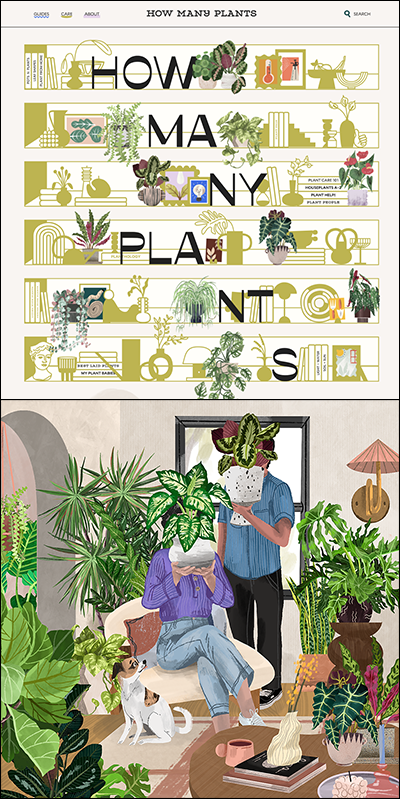
What are you working on—on the side?
“How Many Plants” is a plant-care resource for anyone interested in houseplants, whether you’re a seasoned enthusiast or just getting started. I found a lot of the plant-care information online to be all over the place and often contradictory, so I wanted to build a robust resource that would be fun to engage with and genuinely useful!
I mean, why waste time googling in circles and opening tab after tab only to be more confused than when you started? For this reason, I was intent on creating a “go-to” resource that would not only fully elaborate on the care of specific plants, but also dive deep into larger topics like propagation and dealing with pests. And as a bonus, I wanted to position the whole thing through the lens of design and interiors since that’s my field of expertise. For me, greenery is an essential part of any designer’s toolkit—equal to any piece of furniture or paint color. Plants have the power to transform a space from something pretty good to something downright magical. Often, they’re the missing piece that will make a space come to life … literally! I’m continuously amazed by what a versatile design element plants can be. They can play the role of sculpture, anchoring a space or filling an empty corner. They can bring in heaps of color and texture, playing off other patterns in the space or standing out against solids.
And while I clearly love how plants look in real life, I wanted to take a fresh approach for this project. I found that a lot of plant photography can make plants look somewhat unattainable in either their lushness or setting. Or they are photographed with retail/shipping in mind which usually means they are young, fresh out of the greenhouse and it can be hard to envision their growth. I believed a bit of abstraction would go a long way to inspire and get people excited to imagine plants in their own space. So I was super-lucky to connect with a wonderful illustrator, Evie May Adams, who was willing to dive into this big project with me and take on everything from the illustrations of the plants themselves, along with icons, interiors and tons of one-off vignettes and diagrams for the long-form articles. Truly, the site wouldn’t be what it is without the illustrations.
How do you manage to work on your side project(s)?
To be honest, I was quickly overwhelmed by the scope of the project. What I thought would take 5 or 6 months to get off the ground, ended up taking closer to 9 months. I just had such a specific (and ambitious) vision in my head of what I wanted “HMP” to be, and I was a bit stubborn about the need for it to be fully realized before putting it out into the world. I don’t necessarily think this is the best approach to a side project, but for me, it worked to keep the momentum going strong upfront so the project could then take a bit of a backseat going forward. Also, having something fully baked gave me a more complete picture of how my audience was experiencing the site, which helps me understand what people are liking or missing before building out any additional features.
It’s still a fairly new thing for me, so I can’t say for sure, but it’s my hope that the project will continue to take on a natural rhythm of lulls with more intense activity. Especially as a freelancer, this would nicely mirror how work tends to flow in my day-to-day!
Why have a side project?
While I’m passionate about the topic of plant care, this project was ultimately a way for me to learn a bunch of new skills. I’m trained as an architect and have been working in interiors for the past 6 years, so I had super-minimal web experience before creating this site. I had to learn everything from how to design around breakpoints to how to structure content for CMS and everything in-between.
I was originally inspired to create “How Many Plants” both by circumstance and by my husband, Moe. The circumstance was the pandemic, and Moe happens to be a skilled web developer that has been pursuing side projects since we met in grad school (his career was born out of a side project!). Moe and a bunch of his friends had recently started using a tool called Webflow to quickly build websites without code. And witnessing that work gave me the confidence that I could make something myself. It was also quite exciting to be able to take full creative control of a project—there was no design director, no client, no budget, no external deadline driving my decisions. This freedom was such a huge contrast to what I had experienced in architecture and interior projects. In some ways, it was daunting, but mostly it was just so satisfying. And it created an unexpected feedback loop to my day job that reinvigorated my design thinking and helped me reevaluate my approach to limitations.
• • •
Diptych courtesy of Daniela Covarrubias.
❤️ Donating = Appreciating: Design Feast is on Patreon!
Lots of hours are put into making Design Feast—because it’s a labor of love to provide creative culture to everyone. If you find delight and motivation from the hundreds of interviews, including event write-ups, at Design Feast, please consider becoming a supporting Patron with a recurring monthly donation.
Help keep Design Feast going and growing by visiting my Patreon page where you can watch a short intro video plus view my goals and reward tiers—starting at $1 per month. Starting your patronage today matters—it’ll help Design Feast continue to be an exceptional service, integral to the creative community.
